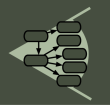|
Difference between
version 2
and
version 1:
| At line 54 added 7 lines. |
| + ! SEEK Extensible Observation Ontology (OBOE) |
| + |
| + OBOE is a formal ontology for capturing the semantics of generic scientific observation and measurement. The ontology provides a convenient basis for adding detailed semantic annotations to scientific data, which crystallize the inherent “meaning” of observational data. The ontology can be used to characterize the context of an observation (e.g., space and time), and clarify inter-observational relationships such as dependency hierarchies (e.g., nested experimental observations) and meaningful dimensions within the data (e.g., axes for cross-classified categorical summarization). It also enables the robust description of measurement units (e.g., grams of carbon per liter of seawater), and can facilitate automatic unit conversions (e.g., pounds to kilograms). The ontology can be easily extended with specialized domain vocabularies, making it both broadly applicable and highly customizable. In particular, explicit “extension points” allow new types of observable entities (e.g., tree, rock, population), characteristics (e.g., height, color, diversity), and unit definitions to be easily added. Finally, we describe the utility of the ontology for enriching the capabilities of data discovery and integration processes. |
| + |
| + *[OBOE paper | oboe_ecological_informatics.pdf ] |
| + *[OBOE ontology | http://ecoinformatics.org/ontologies/observation-0.1.6] |
| + |
| Removed lines 63-68 |
| - ! SEEK Extensible Observation Ontology (OBOE) |
| - |
| - OBOE is a formal ontology for capturing the semantics of generic scientific observation and measurement. The ontology provides a convenient basis for adding detailed semantic annotations to scientific data, which crystallize the inherent “meaning” of observational data. The ontology can be used to characterize the context of an observation (e.g., space and time), and clarify inter-observational relationships such as dependency hierarchies (e.g., nested experimental observations) and meaningful dimensions within the data (e.g., axes for cross-classified categorical summarization). It also enables the robust description of measurement units (e.g., grams of carbon per liter of seawater), and can facilitate automatic unit conversions (e.g., pounds to kilograms). The ontology can be easily extended with specialized domain vocabularies, making it both broadly applicable and highly customizable. In particular, explicit “extension points” allow new types of observable entities (e.g., tree, rock, population), characteristics (e.g., height, color, diversity), and unit definitions to be easily added. Finally, we describe the utility of the ontology for enriching the capabilities of data discovery and integration processes. |
| - |
| - *[OBOE paper | oboe_ecological_informatics.pdf ] |
| - *[OBOE ontology | http://ecoinformatics.org/ontologies/observation-0.1.6] |
Back to Projects,
or to the Page History.
|








